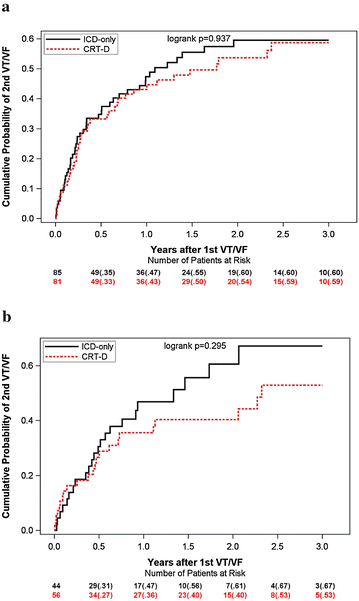Effect of obesity on the effectiveness of cardiac resynchronization to reduce the risk of first and recurrent ventricular tachyarrhythmia events
- PMID: 27388610
- PMCID: PMC4936234
- DOI: 10.1186/s12933-016-0401-x
Effect of obesity on the effectiveness of cardiac resynchronization to reduce the risk of first and recurrent ventricular tachyarrhythmia events
Abstract
Background: Obesity is associated with multiple adverse cardiovascular conditions and may increase the risk of ventricular tachyarrhythmias (VT/VF). There is limited data on the association between obesity and risk of VT/VF requiring appropriate implantable cardioverter-defibrillator (ICD) therapies and the effectiveness of cardiac resynchronization therapy (CRT) to reduce risk for VT/VF. The multicenter automatic defibrillator implantation trial with cardiac resynchronization therapy (MADIT-CRT) was design to investigate effectiveness of CRT therapy to reduce cardiovascular outcome for patients with heart failure (HF) and reduced ejection fraction.
Methods and results: We identified patients enrolled in the MADIT CRT trial as obese (n = 433) and non-obese (n = 845) and analyzed their risk for appropriate device therapy for VT/VF, repeated VT/VF events, fast VT/VF, as well as events after first VT/VF episodes. Obesity was defined as body mass index (BMI) ≥30 kg/m(2). Among ICD patients, the risk of first appropriate ICD therapy for VT/VF at 3 years was similar between obese and non-obese patients (23 vs. 21 %, p = 0.76). CRT-D treatment reduced the risk of first appropriate ICD therapy both in non-obese ([HR]; 0.58 [CI]: 0.42-0.79; p < 0.001) and obese patients (HR 0.75, 95 % CI 0.5-1.38; p = 0.179) (interaction p value 0.323). Similarly, a significant reduction in the risk of fast VT/VF was observed in non-obese patients ([HR]; 0.49 [CI]: 0.33-0.73; p < 0.001) and obese ([HR]; 0.49 [CI]: 0.29-0.81; p < 0.01), (interaction p value 0.984).
Conclusion: Obese and non-obese patients with mild heart failure have a similar risk of ventricular tachyarrhythmias. Obesity in mild heart failure did not diminish the clinical benefit of cardiac resynchronization therapy to reduce risk for appropriate ICD therapy. Clinical trial registration http://clinicaltrials.gov/ct2/show/NCT00180271.
Keywords: Cardiac resynchronization therapy; Heart failure; Implantable cardioverter defibrillator; Obesity; Ventricular tachyarrhythmias.
Figures




Similar articles
-
Response of right ventricular size to treatment with cardiac resynchronization therapy and the risk of ventricular tachyarrhythmias in MADIT-CRT.Heart Rhythm. 2013 Oct;10(10):1471-7. doi: 10.1016/j.hrthm.2013.07.029. Epub 2013 Jul 19. Heart Rhythm. 2013. PMID: 23872690 Clinical Trial.
-
Reduced risk of life-threatening ventricular tachyarrhythmias with cardiac resynchronization therapy: relationship to left ventricular ejection fraction.Eur J Heart Fail. 2015 Sep;17(9):971-8. doi: 10.1002/ejhf.311. Epub 2015 Jul 14. Eur J Heart Fail. 2015. PMID: 26173635 Clinical Trial.
-
Time-dependent risk reduction of ventricular tachyarrhythmias in cardiac resynchronization therapy patients: a MADIT-RIT sub-study.Europace. 2015 Jul;17(7):1085-91. doi: 10.1093/europace/euv008. Epub 2015 Mar 4. Europace. 2015. PMID: 25745075 Clinical Trial.
-
Long-term efficacy of implantable cardiac resynchronization therapy plus defibrillator for primary prevention of sudden cardiac death in patients with mild heart failure: an updated meta-analysis.Heart Fail Rev. 2016 Jul;21(4):447-53. doi: 10.1007/s10741-016-9550-y. Heart Fail Rev. 2016. PMID: 27043219 Review.
-
Roles and indications for use of implantable defibrillator and resynchronization therapy in the prevention of sudden cardiac death in heart failure.Heart Fail Rev. 2016 Jul;21(4):433-46. doi: 10.1007/s10741-016-9542-y. Heart Fail Rev. 2016. PMID: 26910804 Review.
Cited by
-
Associations of levels of peripheral blood leukocyte and subtypes with type 2 diabetes: A longitudinal study of Chinese government employees.Front Endocrinol (Lausanne). 2023 Mar 24;14:1094022. doi: 10.3389/fendo.2023.1094022. eCollection 2023. Front Endocrinol (Lausanne). 2023. PMID: 37033252 Free PMC article.
-
Obesity paradox in patients with reduced ejection fraction eligible for device implantation - an observational study.ESC Heart Fail. 2024 Dec;11(6):3616-3625. doi: 10.1002/ehf2.14961. Epub 2024 Jul 19. ESC Heart Fail. 2024. PMID: 39031161 Free PMC article.
-
Cardiac resynchronization therapy with a defibrillator (CRTd) in failing heart patients with type 2 diabetes mellitus and treated by glucagon-like peptide 1 receptor agonists (GLP-1 RA) therapy vs. conventional hypoglycemic drugs: arrhythmic burden, hospitalizations for heart failure, and CRTd responders rate.Cardiovasc Diabetol. 2018 Oct 22;17(1):137. doi: 10.1186/s12933-018-0778-9. Cardiovasc Diabetol. 2018. PMID: 30348145 Free PMC article.
-
Optimization of Retrospective Gated-ECG Coronary Computed Tomography Angiography by Dose Reduction in Patients with Different Body Mass Indexes.J Biomed Phys Eng. 2025 Jun 1;15(3):281-290. doi: 10.31661/jbpe.v0i0.2209-1537. eCollection 2025 Jun. J Biomed Phys Eng. 2025. PMID: 40510307 Free PMC article.
-
Multipolar pacing by cardiac resynchronization therapy with a defibrillators treatment in type 2 diabetes mellitus failing heart patients: impact on responders rate, and clinical outcomes.Cardiovasc Diabetol. 2017 Jun 9;16(1):75. doi: 10.1186/s12933-017-0554-2. Cardiovasc Diabetol. 2017. PMID: 28599667 Free PMC article. Clinical Trial.
References
Publication types
MeSH terms
Associated data
LinkOut - more resources
Full Text Sources
Other Literature Sources
Medical
Research Materials
Miscellaneous

